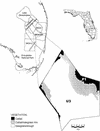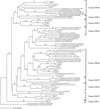Composition and function of sulfate-reducing prokaryotes in eutrophic and pristine areas of the Florida Everglades
- PMID: 12450837
- PMCID: PMC134442
- DOI: 10.1128/AEM.68.12.6129-6137.2002
Composition and function of sulfate-reducing prokaryotes in eutrophic and pristine areas of the Florida Everglades
Abstract
As a result of agricultural activities in regions adjacent to the northern boundary of the Florida Everglades, a nutrient gradient developed that resulted in physicochemical and ecological changes from the original system. Sulfate input from agricultural runoff and groundwater is present in soils of the Northern Everglades, and sulfate-reducing prokaryotes (SRP) may play an important role in biogeochemical processes such as carbon cycling. The goal of this project was to utilize culture-based and non-culture-based approaches to study differences between the composition of assemblages of SRP in eutrophic and pristine areas of the Everglades. Sulfate reduction rates and most-probable-number enumerations revealed SRP populations and activities to be greater in eutrophic zones than in more pristine soils. In eutrophic regions, methanogenesis rates were higher, the addition of acetate stimulated methanogenesis, and SRP able to utilize acetate competed to a limited degree with acetoclastic methanogens. A surprising amount of diversity within clone libraries of PCR-amplified dissimilatory sulfite reductase (DSR) genes was observed, and the majority of DSR sequences were associated with gram-positive spore-forming Desulfotomaculum and uncultured microorganisms. Sequences associated with Desulfotomaculum fall into two categories: in the eutrophic regions, 94.7% of the sequences related to Desulfotomaculum were associated with those able to completely oxidize substrates, and in samples from pristine regions, all Desulfotomaculum-like sequences were related to incomplete oxidizers. This metabolic selection may be linked to the types of substrates that Desulfotomaculum spp. utilize; it may be that complete oxidizers are more versatile and likelier to proliferate in nutrient-rich zones of the Everglades. Desulfotomaculum incomplete oxidizers may outcompete complete oxidizers for substrates such as hydrogen in pristine zones where diverse carbon sources are less available.
Figures



References
-
- Bak, F., and N. Pfennig. 1991. Microbial sulfate reduction in littoral sediment of Lake Constance. FEMS Microbiol. Ecol. 85:31-42.
-
- Bates, A. L., W. H. Orem, J. W. Harvey, and E. C. Spiker. 2002. Tracing sources of sulfur in the Florida Everglades. J. Environ. Qual. 31:287-299. - PubMed
-
- Bates, A. L., E. C. Spiker, and C. W. Holmes. 1998. Speciation and isotopic composition of sedimentary sulfur in the Everglades, Florida, USA. Chem. Geol. 146:155-170.
-
- Cappenberg, T. E. 1974. Interrelations between sulfate-reducing and methane-producing bacteria in bottom deposits of a freshwater lake. I. Field observations. Antonie Leeuwenhoek 40:285-295. - PubMed
Publication types
MeSH terms
Substances
LinkOut - more resources
Full Text Sources
Research Materials
Miscellaneous

